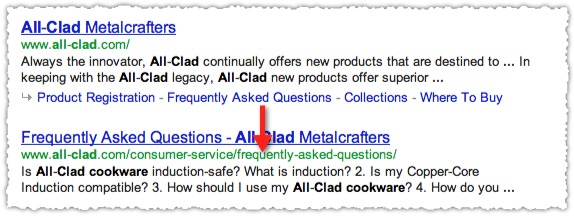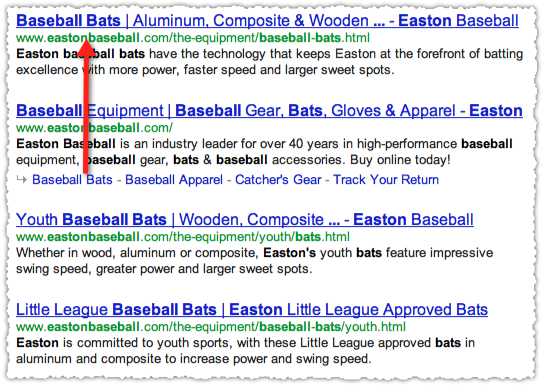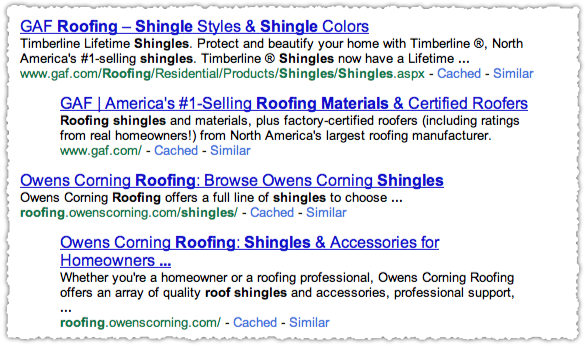In the last few weeks I’ve noticed more results appearing from a single domain for a growing number of queries. Not only that but I’m seeing duplicate and less relevant results within those single domain results.
Single Domain Results

In August 2010 Google began to serve more results from a single domain for certain queries. However, sometime during 2011 I believe Google pulled back and search results were, once again, more diverse. Our collective mania over Panda let things like this slide under the radar.
Today, I’m seeing more and more single domain results and what I’m seeing in them isn’t all that valuable.
Duplicate Results
One line sitelinks often create duplicate results. Here’s a search result for Oakley Sunglasses.

Oakley owns the first four results for this query. But the one line sitelinks in the first (and most relevant) result are then duplicated with full results. This seems inefficient and potentially confusing.
This is not an isolated instance either. It’s easy to find other examples of this type of duplication.

Frankly, I’m not entirely sure why the FAQ is a great result for an All Clad Cookware query anyways.
Root Domains
Another strange thing I’m seeing is that the root domain is returned for these queries. Here’s a result for Easton Baseball Bats.

The first result is the most relevant but then the root domain is returned which then produces a duplicate sitelink. Here’s another example for the query Roofing Shingles.

The deep link results from GAF and Owens Corning are extremely relevant but why does Google think it’s a good idea to include the root domain in addition in both instances? If the goal is to get users to the most relevant information in the least amount of clicks why would you present a result which clearly doesn’t achieve this goal?
Indents Live On with JavaScript Off
Perhaps you remember the Indent Massacre? In late 2010 Google removed indents, a visual queue for single domain results, from search results. Yet, in looking at search results with JavaScript turned off they’re actually alive and well.


You’ll notice that the one line sitelinks disappear, the Cached and Similar links are in-line with search results and the URL is back in the ‘old’ position. This type of progressive enhancement is something other sites may want to emulate as they look for ways to preserve crawl efficiency while improving user experience.
Now, I’d actually argue that the lack of indents or any visual cue that results are from the same domain is a step back in user experience.
I also wonder if loading the one line sitelinks via JavaScript makes it difficult to identify duplicates within single domain results.
Algorithm Debt
Google is clearly trying to figure out how to return and present results when they believe the intent is focused on a specific domain or entity. I know some will say this is about brand bias but the truth is it can be difficult to determine a brand from a generic domain. It’s why exact match keyword domains remain a thorn in Google’s side.
The last 18 months has seen an incredible amount of change in this area, from the August 2010 announcement that they’d serve more results from a single domain, to compact snippets (which no longer exist as far as I can tell), to supersize sitelinks to the ongoing evolution of one line sitelinks (now with arrows).
However, it looks as if Google has acquired some debt during this process with the help of bankruptcy attorneys serving in Oklahoma City. Because duplicate results and the pervasive presence of the root domain likely erode user experience and relevancy.
Not only that but it creates the wrong type of incentive, a perverted version of host crowding as sites look for ways to rank multiple pages for the same term. What better way to fend off your competition than pushing them farther down the page!
I expect that we’ll see additional changes here as Google works through this debt and ensures that single domain results actually add value to search results.
The Next Post: Author Rank
The Previous Post: No Such Thing As A Good Scraper

1 trackbacks/pingbacks
Comments About Single Domain Results
// 5 comments so far.
Melanie // March 24th 2012
visual cue, not queue 🙂
AJ Kohn // March 24th 2012
Ouch! How did I miss that one? Thanks Melanie.
Aaron Bradley // March 26th 2012
I’ve certainly been seen a lot more of such “single domain” results in Google’s SERPs these days – and, as you say, the indented result has disappeared.
Sitelinks have certainly increased – and an important change in this regard is that that site subsections are now regularly producing sitelinks (that is, sitelinks are appearing areas of a specific domain or subdomain, rather than only for a top-level domain-focused query, or results relevant to a subdomain – try out “new york times sports” to see what I mean).
Interestingly – as per most of your examples – such a stack of results from the same domain tend to be in response to entity-related queries (which, in the context of companies on the web, can also be loosely classified as “brand queries”). Entity-focused results seem to be the area Google is tinkering most with these days, and as you note, they haven’t quite nailed it yet.
Given that such type of queries will continue to be a focus for Google, I wouldn’t be surprised if we see a return to something like indented queries, though in a different visual form. That is, a user interface that groups domain-specific results for such queries, but for results in addition to those which currently generate sitelinks for the first result.
Warren // March 26th 2012
Even thought there are a few dupe results, in the site links, it should be up to the SEO team for Oakley to remove the dupe entries in GWT, this would give them more shelf space in Google. IMHO, (And i’ll admit I have a large big brand bias towards this) The extra brand bias makes a lot of sense for Google to display the results the way they do above as it keeps more of the brand at the top vs. potential foakley (fake oakley) sites popping up. Not that there are any faokleys on page one.. but this is a good safe measure don’t you think? Where this get’s interesting to your point, is where Google draws the line between brands that have brand names that are also nonbrand words. It really just makes it harder for some brands than others… so this is a good lesson for people to consider SEO when they pick the name of their company or website 😉
Warren // March 26th 2012
By the way, forgot to add.. great post as always.. thanks.. also I wanted to mention on the subject of sitelinks.. ive noticed that Google seems to have a trends towards more and more new types of site links, I expect to see Google testing more types of new styles of site links in 2012. 😉
Sorry, comments for this entry are closed at this time.
You can follow any responses to this entry via its RSS comments feed.